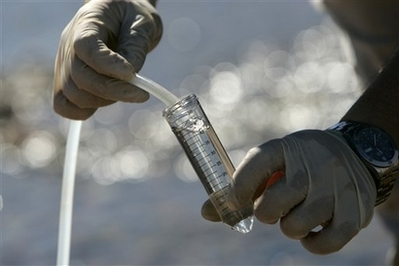Drugs found in drinking water for 41m Americans
(Xinhua)
Updated: 2008-03-10 08:05
Updated: 2008-03-10 08:05
LOS ANGELES -- A probe has found that drinking water for at least 41 million Americans contains a vast array of pharmaceuticals, including antibiotics, anti-convulsants, mood stabilizers and sex hormones.
 Duane Moser, an assistant research professor with Desert Research Institute, collects water samples from the Las Vegas Wash in Henderson, Nev. in this Oct. 18, 2007 file photo. A probe has found that drinking water for at least 41 million Americans contains a vast array of pharmaceuticals, including antibiotics, anti-convulsants, mood stabilizers and sex hormones. [Agencies] |
Drugs have been detected in the drinking water supplies of 24 major metropolitan areas - from Southern California to Northern New Jersey, from Detroit to Louisville, Kentucky, according to the probe made public on Sunday.
"The presence of so many prescription drugs - and over-the- counter medicines like acetaminophen and ibuprofen - in so much of our drinking water is heightening worries among scientists of long- term consequences to human health," said the probe conducted by the Associated Press.
But the probe said the concentrations of these pharmaceuticals are tiny, measured in quantities of parts per billion or trillion, far below the levels of a medical dose. Also, utilities insist their water is safe.
Water providers rarely disclose results of pharmaceutical screenings, unless pressed, the probe found. For example, the head of a group representing major California suppliers said the public "doesn't know how to interpret the information" and might be unduly alarmed.
In the course of a five-month inquiry, members of the AP National Investigative Team reviewed hundreds of scientific reports, analyzed federal drinking water databases, visited environmental study sites and treatment plants and interviewed more than 230 officials, academics and scientists. They also surveyed the nation's 50 largest cities and a dozen other major water providers, as well as smaller community water providers in all 50 states.
Explaining how do the drugs get into the water, the probe said:
"People take pills. Their bodies absorb some of the medication, but the rest of it passes through and is flushed down the toilet. The wastewater is treated before it is discharged into reservoirs, rivers or lakes. Then, some of the water is cleansed again at drinking water treatment plants and piped to consumers. But most treatments do not remove all drug residue."
"And while researchers do not yet understand the exact risks from decades of persistent exposure to random combinations of low levels of pharmaceuticals, recent studies - which have gone virtually unnoticed by the general public - have found alarming effects on human cells and wildlife," said the probe.
The AP's investigation also indicates that watersheds, the natural sources of most of the nation's water supply, also are contaminated.
"We recognize it is a growing concern and we're taking it very seriously," Benjamin H. Grumbles, assistant administrator for water at the U.S. Environmental Protection Agency, was quoted as saying.
|
|
|
||
|
||
|
|
|
|